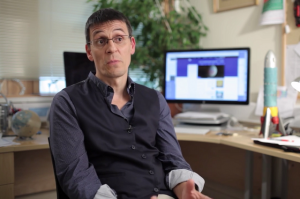Exoplanets
Astrophysicist Didier Queloz on the how to find exoplanets, their impact on astronomy, and the uniqueness of o...
What is the difference between bosons and fermions? What is the limit of supergravity theory? What changes when we pass from our 4-dimensional world to 11 dimensions? Is it possible to describe a complex world in a simple unique theory? Mathematician Hadi Godazgar answers all this sophisticated questions.
There are two types of particles in nature called boson and fermions. So in quantum physics all particles have spin. You can think of this as just a rotation of an object around it’s own axis – just as the Earth rotates on it’s own axis and gives rise to day and night. So in quantum physics there is a related notion and that goes by the name of spin except that in quantum physics spin is fixed to a particular value. So each particle has spin but that spin is fixed. And it could only be an integer, so 0, 1, 2, 3 and so on, and these particles are called bosons. Or spin can be halved, just so half, three halves, five halves and so on – these particles are called fermions.
In a theory of supersymmetry each particle has a partner, a twin. And if the original particle is a fermion, for example, an electron, it has a boson partner. And this is true for all of the particles. So in some sense supersymmetry restores the balance between the fermions and bosons in the existing nature. And there are many particle physics’s motivations for doing this, there are problems the supersymmetry aimes to solve. And in fact suppersymmetry is being surched for in the LHC (The Large Hadron Collider) at CERN at the moment. And if it’s discovered it would be a very revolutionary event in theoretical physisc.
One could think of Kaluza-Klein theory as of simplifying the complexity by going to higher dimension. And this is why I sad that n fact the existence of the unique supergravity in a higher dimension can be thought of as an advantage, because we know that the world is complicated, there are all sorts of various interactions and many different parameters to change the strength of all of these interactions. So there is no way of writing down a single theory that describes all of this and that’s unique. But if we go to a higher dimension we do have unique theories.

Astrophysicist Didier Queloz on the how to find exoplanets, their impact on astronomy, and the uniqueness of o...

Matematician Hadi Godazgar on the Big Bang, black holes, and the Information Paradox

Cosmologist Martin Rees on life in the Solar System, artificial transmissions, and inorganic civilizations.